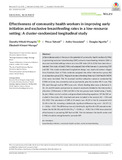Effectiveness of community health workers in improving early initiation and exclusive breastfeeding rates in a low-resource setting: A cluster-randomized longitudinal study

View/
Date
2020-04Author
Mungiria, D. M.
Tuitoek, Prisca J.
Varpolatai, A.
Ngotho, D.
Murage, E. K.
Metadata
Show full item recordAbstract
Little evidence exists in Kenya on the potential of community health workers (CHWs) in promoting exclusive breastfeeding (EBF) and early breastfeeding initiation (EBI) in resource‐restricted settings where very low EBF rates (2% to 12%) have been documented. The study utilized CHWs and assessed their effectiveness in promoting EBF and EBI. The cluster‐randomized longitudinal design was used and sixteen villages from Kiandutu Slum in Thika randomly assigned into either intervention group (IG) or comparison group (CG). Pregnant women attending Maternal Child Health (MCH) clinic were recruited. The IG received nutrition education sessions conducted by CHWs at home, two prenatally and six postnatally, plus the routine MCH care. The CG went through routine MCH care only. Infants feeding data were collected at 6, 10, 14, and 24 weeks postpartum by research assistants blinded to the intervention allocation. Differences in EBF and EBI in the two groups were tested using χ² tests, Kaplan–Meier survival analysis and generalized estimating equations. Of the 526 recruited in the study, 431 remained and were included in the analysis (IG = 176) and CG (225). The prevalence of EBF at 24 weeks was 45.3% in the IG compared with 15.0% in the CG, revealing a statistically significant difference log rank = 20.277, (1, n = 314) p < .001. The difference was not statistically significant in EBI prevalence between the IG (58.2%) and CG (60.3%; χ² = 0.008, p = .928). The CHWs have potential effectiveness in promoting EBF but not EBI. The link between the health center and CHWs should be strengthened to promote EBF.
URI
https://onlinelibrary.wiley.com/doi/epdf/10.1002/fsn3.1559https://www.researchgate.net/publication/341003489_Effectiveness_of_community_health_workers_in_improving_early_initiation_and_exclusive_breastfeeding_rates_in_a_low-resource_setting_A_cluster-randomized_longitudinal_study
http://hdl.handle.net/123456789/4406
https://doi.org/10.1002/fsn3.1559
Collections
- Journal Articles (PAS) [285]
